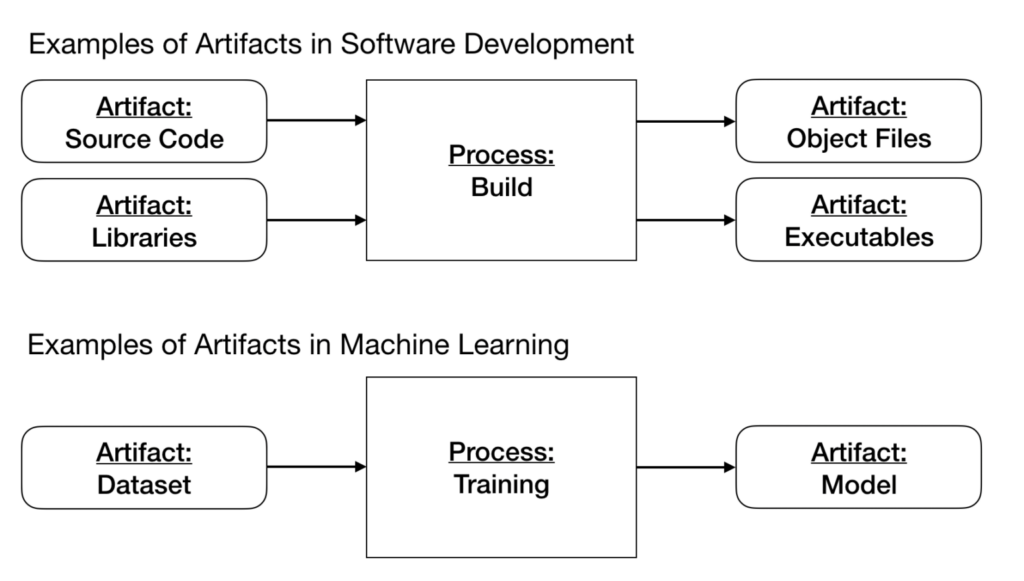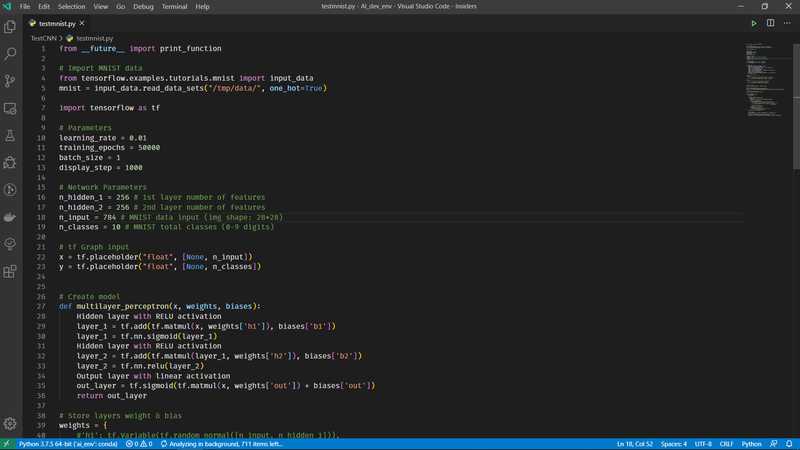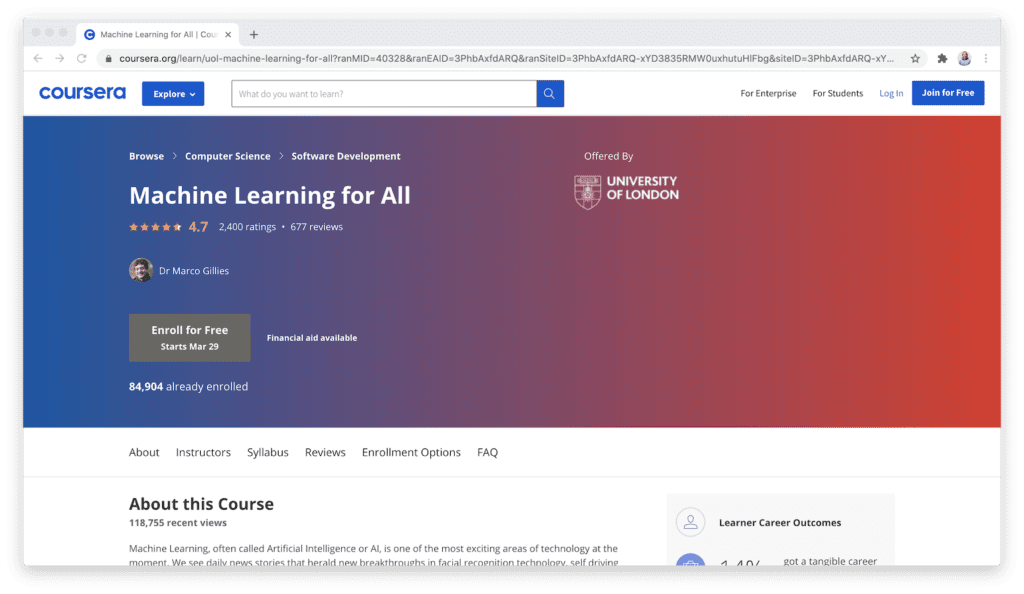All Categories
Featured
Table of Contents
- – Some Ideas on Pursuing A Passion For Machine L...
- – Facts About Best Online Machine Learning Cours...
- – Fascination About How I’d Learn Machine Learn...
- – Get This Report on Online Machine Learning En...
- – How Untitled can Save You Time, Stress, and ...
- – Not known Facts About 7 Best Machine Learnin...
You most likely know Santiago from his Twitter. On Twitter, every day, he shares a whole lot of functional aspects of artificial intelligence. Many thanks, Santiago, for joining us today. Welcome. (2:39) Santiago: Thank you for welcoming me. (3:16) Alexey: Prior to we enter into our main subject of moving from software program design to equipment understanding, perhaps we can begin with your history.
I began as a software application developer. I went to college, got a computer scientific research degree, and I started building software application. I think it was 2015 when I chose to go for a Master's in computer science. At that time, I had no concept regarding maker understanding. I didn't have any type of rate of interest in it.
I know you have actually been making use of the term "transitioning from software application design to device knowing". I such as the term "adding to my skill set the machine understanding skills" extra since I think if you're a software engineer, you are already supplying a lot of value. By integrating equipment knowing now, you're enhancing the effect that you can carry the sector.
Alexey: This comes back to one of your tweets or maybe it was from your training course when you contrast two strategies to understanding. In this situation, it was some trouble from Kaggle about this Titanic dataset, and you simply learn just how to address this issue using a specific tool, like choice trees from SciKit Learn.
Some Ideas on Pursuing A Passion For Machine Learning You Need To Know
You initially find out mathematics, or linear algebra, calculus. When you recognize the mathematics, you go to maker knowing concept and you learn the theory.
If I have an electric outlet here that I need replacing, I do not wish to most likely to college, invest four years understanding the mathematics behind electricity and the physics and all of that, just to change an electrical outlet. I would instead start with the electrical outlet and discover a YouTube video clip that aids me go with the issue.
Santiago: I really like the idea of beginning with an issue, attempting to toss out what I recognize up to that trouble and understand why it does not work. Grab the tools that I need to address that trouble and begin excavating much deeper and much deeper and deeper from that point on.
Alexey: Possibly we can speak a little bit about discovering resources. You stated in Kaggle there is an intro tutorial, where you can obtain and learn just how to make choice trees.
The only requirement for that course is that you understand a little bit of Python. If you go to my account, the tweet that's going to be on the top, the one that claims "pinned tweet".
Facts About Best Online Machine Learning Courses And Programs Revealed

Even if you're not a developer, you can start with Python and function your means to even more artificial intelligence. This roadmap is concentrated on Coursera, which is a system that I really, truly like. You can examine all of the programs free of cost or you can pay for the Coursera subscription to obtain certificates if you intend to.
Alexey: This comes back to one of your tweets or possibly it was from your course when you contrast two methods to knowing. In this case, it was some trouble from Kaggle concerning this Titanic dataset, and you just learn how to resolve this trouble utilizing a particular device, like choice trees from SciKit Learn.

You first find out mathematics, or direct algebra, calculus. When you recognize the mathematics, you go to equipment understanding theory and you learn the concept.
If I have an electric outlet here that I need changing, I do not wish to most likely to university, invest four years recognizing the mathematics behind electricity and the physics and all of that, simply to change an outlet. I would instead start with the electrical outlet and find a YouTube video clip that helps me undergo the problem.
Poor analogy. You obtain the concept? (27:22) Santiago: I truly like the concept of starting with a trouble, trying to throw away what I know up to that problem and understand why it does not work. Order the tools that I require to address that trouble and begin digging deeper and deeper and deeper from that factor on.
That's what I normally recommend. Alexey: Maybe we can chat a bit concerning learning sources. You mentioned in Kaggle there is an introduction tutorial, where you can obtain and find out just how to make decision trees. At the start, prior to we began this meeting, you discussed a couple of books.
Fascination About How I’d Learn Machine Learning In 2024 (If I Were Starting ...
The only demand for that program is that you recognize a little bit of Python. If you go to my account, the tweet that's going to be on the top, the one that states "pinned tweet".
Also if you're not a programmer, you can start with Python and function your method to even more equipment learning. This roadmap is focused on Coursera, which is a platform that I actually, really like. You can examine all of the programs free of cost or you can spend for the Coursera membership to get certificates if you intend to.
Get This Report on Online Machine Learning Engineering & Ai Bootcamp
Alexey: This comes back to one of your tweets or maybe it was from your course when you contrast two approaches to knowing. In this instance, it was some issue from Kaggle regarding this Titanic dataset, and you just find out exactly how to resolve this trouble making use of a details tool, like decision trees from SciKit Learn.

You initially learn mathematics, or direct algebra, calculus. When you recognize the mathematics, you go to device understanding concept and you learn the concept.
If I have an electric outlet here that I need replacing, I do not wish to most likely to college, spend four years understanding the mathematics behind electrical energy and the physics and all of that, simply to alter an outlet. I prefer to begin with the electrical outlet and discover a YouTube video that assists me experience the trouble.
Bad example. However you obtain the idea, right? (27:22) Santiago: I really like the concept of starting with a trouble, trying to throw out what I know as much as that trouble and comprehend why it does not function. Get hold of the tools that I require to fix that problem and start digging deeper and much deeper and deeper from that factor on.
That's what I normally recommend. Alexey: Maybe we can talk a little bit about discovering resources. You stated in Kaggle there is an intro tutorial, where you can obtain and discover exactly how to make choice trees. At the beginning, before we began this meeting, you stated a couple of publications.
How Untitled can Save You Time, Stress, and Money.
The only requirement for that training course is that you recognize a little bit of Python. If you go to my account, the tweet that's going to be on the top, the one that says "pinned tweet".
Even if you're not a programmer, you can start with Python and function your method to more machine discovering. This roadmap is concentrated on Coursera, which is a system that I really, really like. You can investigate all of the programs totally free or you can spend for the Coursera subscription to obtain certificates if you want to.
Alexey: This comes back to one of your tweets or maybe it was from your program when you compare 2 methods to learning. In this case, it was some issue from Kaggle regarding this Titanic dataset, and you simply discover exactly how to solve this trouble using a specific device, like decision trees from SciKit Learn.
You initially discover math, or direct algebra, calculus. When you recognize the math, you go to device discovering theory and you learn the concept. Then 4 years later, you lastly pertain to applications, "Okay, how do I use all these 4 years of math to fix this Titanic issue?" ? In the previous, you kind of save yourself some time, I believe.
Not known Facts About 7 Best Machine Learning Courses For 2025 (Read This First)
If I have an electric outlet below that I need replacing, I do not intend to go to university, invest 4 years understanding the math behind electrical energy and the physics and all of that, just to change an electrical outlet. I prefer to begin with the electrical outlet and locate a YouTube video clip that helps me go through the trouble.
Bad analogy. However you understand, right? (27:22) Santiago: I actually like the idea of beginning with an issue, trying to toss out what I understand as much as that problem and understand why it doesn't work. Order the tools that I require to fix that problem and begin excavating much deeper and much deeper and deeper from that factor on.

That's what I normally recommend. Alexey: Perhaps we can speak a bit regarding discovering resources. You discussed in Kaggle there is an introduction tutorial, where you can get and learn just how to make choice trees. At the beginning, prior to we began this meeting, you pointed out a couple of books.
The only need for that course is that you understand a little bit of Python. If you go to my profile, the tweet that's going to be on the top, the one that claims "pinned tweet".
Also if you're not a designer, you can begin with Python and function your way to more artificial intelligence. This roadmap is concentrated on Coursera, which is a platform that I actually, truly like. You can examine all of the programs free of cost or you can spend for the Coursera membership to get certificates if you wish to.
Table of Contents
- – Some Ideas on Pursuing A Passion For Machine L...
- – Facts About Best Online Machine Learning Cours...
- – Fascination About How I’d Learn Machine Learn...
- – Get This Report on Online Machine Learning En...
- – How Untitled can Save You Time, Stress, and ...
- – Not known Facts About 7 Best Machine Learnin...
Latest Posts
Senior Software Engineer Interview Study Plan – A Complete Guide
Tips For Acing A Technical Software Engineering Interview
How To Master Whiteboard Coding Interviews
More
Latest Posts
Senior Software Engineer Interview Study Plan – A Complete Guide
Tips For Acing A Technical Software Engineering Interview
How To Master Whiteboard Coding Interviews